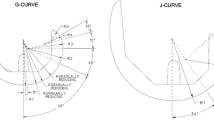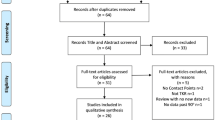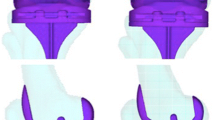Abstract
Introduction
The variability in patients’ femoral and tibial anatomy requires to use different tibia component sizes with the same femoral component size. These size combinations are allowed by manufacturers, but the clinical impact remains unclear. Therefore, the goals of our study were to investigate whether combining different sizes has an impact on the kinematics for two well-established knee systems and to compare these systems’ kinematics to the native kinematics.
Materials and methods
Six fresh frozen knee specimens were tested in a force controlled knee rig before and after implantation of a cruciate retaining (CR) and a posterior-stabilized (PS) implant. Femoro-tibial kinematics were recorded using a ultrasonic-based motion analysis system while performing a loaded squat from 30° to 130°. In each knee, the original best fit inlay was then replaced by different inlays simulating a smaller or bigger tibia component. The kinematics obtained with the simulated sizes were compared to the original inlay kinematics using descriptive statistics.
Results
For all size combinations, the difference to the original kinematics reached an average of 1.3 ± 3.3 mm in translation and − 0.1 ± 1.2° in rotation with the CR implant. With the PS implant, the average differences reached 0.4 ± 2.7 mm and − 0.2 ± 0.8°. Among all knees, no size combination consistently resulted in significantly different kinematics.
Each knee showed a singular kinematic pattern. For both knee systems, the rotation was smaller than in the native knee, but the direction of the rotation was preserved. The PS showed more rollback and the CR less rollback than the native knee.
Conclusion
TKA systems designed with a constant tibio-femoral congruency among size combinations should enable to combine different sizes without having substantial impact on the kinematics. The rotational pattern was preserved by both TKA systems, while the rollback could only be maintained by the PS design.








Similar content being viewed by others
References
Jiang C, Liu Z, Wang Y et al (2016) Posterior cruciate ligament retention versus posterior stabilization for total knee arthroplasty: a meta-analysis. PLoS ONE. https://doi.org/10.1371/journal.pone.0147865
Song SJ, Park CH, Bae DK (2019) What to know for selecting cruciate-retaining or posterior-stabilized total knee arthroplasty. Clin Orthop Surg 11:142–150. https://doi.org/10.4055/cios.2019.11.2.142
Li N, Tan Y, Deng Y et al (2014) Posterior cruciate-retaining versus posterior stabilized total knee arthroplasty: a meta-analysis of randomized controlled trials. Knee Surg Sports Traumatol Arthrosc 22:556–564. https://doi.org/10.1007/s00167-012-2275-0
Nikolaou VS, Chytas D, Babis GC (2014) Common controversies in total knee replacement surgery: current evidence. World J Orthop 5:460–468. https://doi.org/10.5312/wjo.v5.i4.460
Angerame M, Holst D, Jennings J et al (2019) Total knee arthroplasty kinematics. J Arthroplasty 34:2502–2510. https://doi.org/10.1016/j.arth.2019.05.037
Broberg JS, Ndoja S, MacDonald SJ et al (2020) Comparison of contact kinematics in posterior-stabilized and cruciate-retaining total knee arthroplasty at long-term follow-up. J Arthroplasty 35:272–277. https://doi.org/10.1016/j.arth.2019.07.046
Dennis DA, Komistek RD, Mahfouz MR et al (2003) Multicenter determination of in vivo kinematics after total knee arthroplasty. Clin Orthop Relat Res. 416:37–57. https://doi.org/10.1097/01.blo.0000092986.12414.b5
Dai Y, Scuderi GR, Penninger C et al (2014) Increased shape and size offerings of femoral components improve fit during total knee arthroplasty. Knee Surg Sports Traumatol Arthrosc 22:2931–2940. https://doi.org/10.1007/s00167-014-3163-6
Mahfouz M, Abdel Fatah EE, Bowers LS et al (2012) Three-dimensional morphology of the knee reveals ethnic differences. Clin Orthop Relat Res 470:172–185. https://doi.org/10.1007/s11999-011-2089-2
Li P, Tsai T-Y, Li J-S et al (2014) Opmaak 1 // Morphological measurement of the knee: Race and sex effects. Acta Orthop Belg 80:260–268
Daines BK, Dennis DA (2014) Gap balancing vs. measured resection technique in total knee arthroplasty. Clin Orthop Surg 6:1–8. https://doi.org/10.4055/cios.2014.6.1.1
Shervin D, Pratt K, Healey T et al (2015) Anterior knee pain following primary total knee arthroplasty. World J Orthop 6:795–803. https://doi.org/10.5312/wjo.v6.i10.795
Scott RD (2013) Femoral and tibial component rotation in total knee arthroplasty: methods and consequences. Bone Joint J. 95B:140–143. https://doi.org/10.1302/0301-620X.95B11.32765
Martin S, Saurez A, Ismaily S et al (2014) Maximizing tibial coverage is detrimental to proper rotational alignment. Clin Orthop Relat Res 472:121–125. https://doi.org/10.1007/s11999-013-3047-y
Clary C, Aram L, Deffenbaugh D et al (2014) Tibial base design and patient morphology affecting tibial coverage and rotational alignment after total knee arthroplasty. Knee Surg Sports Traumatol Arthrosc 22:3012–3018. https://doi.org/10.1007/s00167-014-3402-x
Nicoll D, Rowley DI (2010) Internal rotational error of the tibial component is a major cause of pain after total knee replacement. J Bone Joint Surg Br 92:1238–1244. https://doi.org/10.1302/0301-620X.92B9.23516
Klasan A, Twiggs JG, Fritsch BA et al (2020) Correlation of tibial component size and rotation with outcomes after total knee arthroplasty. Arch Orthop Trauma Surg 140:1819–1824. https://doi.org/10.1007/s00402-020-03550-z
Schai PA, Thornhill TS, Scott RD (1998) Total knee arthroplasty with the PFC system. Results at a minimum of ten years and survivorship analysis. J Bone Joint Surg Br 80:850–858
Young SW, Clarke HD, Graves SE et al (2015) Higher rate of revision in pfc sigma primary total knee arthroplasty with mismatch of femoro-tibial component sizes. J Arthroplasty 30:813–817. https://doi.org/10.1016/j.arth.2014.11.035
Heylen S, Foubert K, van Haver A et al (2016) Effect of femoro-tibial component size mismatch on outcome in primary total knee replacement. Knee 23:532–534. https://doi.org/10.1016/j.knee.2016.03.003
Pellengahr C, Müller PE, Dürr HR et al (2005) The influence of the implant size on the outcome of unconstrained total knee arthroplasty. Acta Chir Belg 105:508–510. https://doi.org/10.1080/00015458.2005.11679769
Grupp TM, Stulberg D, Kaddick C et al (2009) Fixed bearing knee congruency—influence on contact mechanics, abrasive wear and kinematics. Int J Artif Organs 32:213–223. https://doi.org/10.1177/039139880903200405
Mihalko WM, Lowell J, Higgs G et al (2016) Total knee post-cam design variations and their effects on kinematics and wear patterns. Orthopedics 39:S45–S49. https://doi.org/10.3928/01477447-20160509-14
Steinbrueck A, Schroder C, Woiczinski M et al (2013) Patellofemoral contact patterns before and after total knee arthroplasty: an in vitro measurement. Biomed Eng Online 12:58. https://doi.org/10.1186/1475-925X-12-58
Steinbrueck A, Schroder C, Woiczinski M et al (2017) Mediolateral femoral component position in TKA significantly alters patella shift and femoral roll-back. Knee Surg Sports Traumatol Arthrosc 25:3561–3568. https://doi.org/10.1007/s00167-017-4633-4
Steinbrueck A, Schroeder C, Woiczinski M et al (2018) A lateral retinacular release during total knee arthroplasty changes femorotibial kinematics: an in vitro study. Arch Orthop Trauma Surg 138:401–407. https://doi.org/10.1007/s00402-017-2843-3
Steinbrueck A, Schröder C, Woiczinski M et al (2016) Femorotibial kinematics and load patterns after total knee arthroplasty: an in vitro comparison of posterior-stabilized versus medial-stabilized design. Clin Biomech (Bristol, Avon) 33:42–48. https://doi.org/10.1016/j.clinbiomech.2016.02.002
Steinbruck A, Schroder C, Woiczinski M et al (2016) Influence of tibial rotation in total knee arthroplasty on knee kinematics and retropatellar pressure: an in vitro study. Knee Surg Sports Traumatol Arthrosc 24:2395–2401. https://doi.org/10.1007/s00167-015-3503-1
Pennock GR, Clark KJ (1990) An anatomy-based coordinate system for the description of the kinematic displacements in the human knee. J Biomech 23:1209–1218
Varadarajan KM, Harry RE, Johnson T et al (2009) Can in vitro systems capture the characteristic differences between the flexion-extension kinematics of the healthy and TKA knee? Med Eng Phys 31:899–906. https://doi.org/10.1016/j.medengphy.2009.06.005
D’Lima DD, Trice M, Urquhart AG et al (2000) Comparison between the kinematics of fixed and rotating bearing knee prostheses. Clin Orthop Relat Res 380:151–157. https://doi.org/10.1097/00003086-200011000-00020
Qi W, Hosseini A, Tsai TY et al (2013) In vivo kinematics of the knee during weight bearing high flexion. J Biomech 46:1576–1582. https://doi.org/10.1016/j.jbiomech.2013.03.014
Donadio J, Pelissier A, Boyer P et al (2015) Control of paradoxical kinematics in posterior cruciate-retaining total knee arthroplasty by increasing posterior femoral offset. Knee Surg Sports Traumatol Arthrosc 23:1631–1637. https://doi.org/10.1007/s00167-015-3561-4
Dennis DA, Komistek RD, Mahfouz MR et al (2004) A multicenter analysis of axial femorotibial rotation after total knee arthroplasty. Clin Orthop Relat Res. https://doi.org/10.1097/01.blo.0000148777.98244.84
Fantozzi S, Catani F, Ensini A et al (2006) Femoral rollback of cruciate-retaining and posterior-stabilized total knee replacements: in vivo fluoroscopic analysis during activities of daily living. J Orthop Res 24:2222–2229. https://doi.org/10.1002/jor.20306
Bellemans J, Banks S, Victor J et al (2002) Fluoroscopic analysis of the kinematics of deep flexion in total knee arthroplasty. Influence of posterior condylar offset. J Bone Joint Surg Br 84:50–53
Victor J, Banks S, Bellemans J (2005) Kinematics of posterior cruciate ligament-retaining and -substituting total knee arthroplasty: a prospective randomised outcome study. J Bone Joint Surg Br 87:646–655
Victor J, Labey L, Wong P et al (2010) The influence of muscle load on tibiofemoral knee kinematics. J Orthop Res 28:419–428. https://doi.org/10.1002/jor.21019
Berend ME, Small SR, Ritter MA et al (2010) Effects of femoral component size on proximal tibial strain with anatomic graduated components total knee arthroplasty. J Arthroplasty 25:58–63. https://doi.org/10.1016/j.arth.2008.11.003
Sathasivam S, Walker PS (1994) Optimization of the bearing surface geometry of total knees. J Biomech 27:255–264. https://doi.org/10.1016/0021-9290(94)90002-7
Acknowledgements
The authors thank Rachel Lang, Aesculap AG, for her support in planning the study and Adrian Sauer, Aesculap AG, for his support in performing the tests.
Author information
Authors and Affiliations
Corresponding author
Ethics declarations
Conflict of interest
(ID, IMG) are employees of the Aesculap AG, Tuttlingen, a manufacturer of orthopaedic implants. Three of the authors (VJ, PEM, AS) are advising surgeons in Aesculap R&D project. Four of the authors (VJ, PEM, AS, MW) received institutional funding from Aesculap.
Additional information
Publisher's Note
Springer Nature remains neutral with regard to jurisdictional claims in published maps and institutional affiliations.
Appendix
Appendix
Appendix A: Kinematics obtained with different Columbus DD size combinations.
Figures
9,
10,
11.
Appendix B: Kinematics obtained with different Vega PS size combinations.
Figures
12,
13,
Appendix C: Medial and lateral translation of the condyles for the native knee and after TKA.
Figures
Rights and permissions
About this article
Cite this article
Dupraz, I., Thorwächter, C., Grupp, T.M. et al. Impact of femoro-tibial size combinations and TKA design on kinematics. Arch Orthop Trauma Surg 142, 1197–1212 (2022). https://doi.org/10.1007/s00402-021-03923-y
Received:
Accepted:
Published:
Issue Date:
DOI: https://doi.org/10.1007/s00402-021-03923-y













